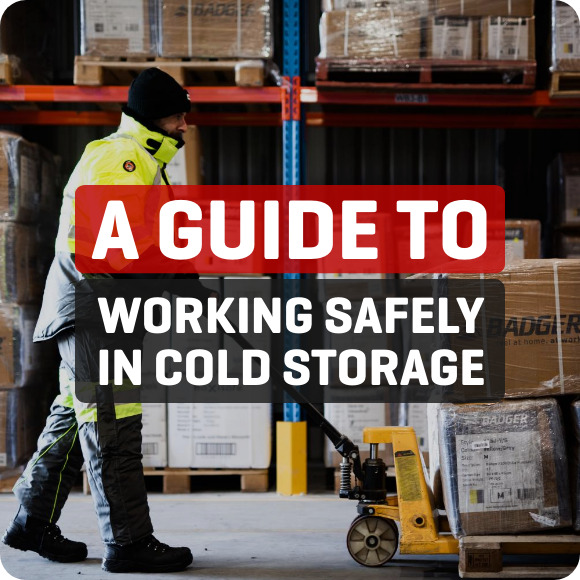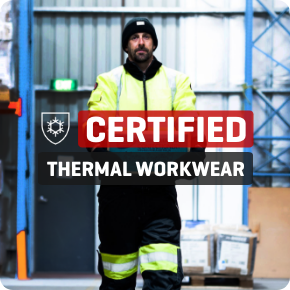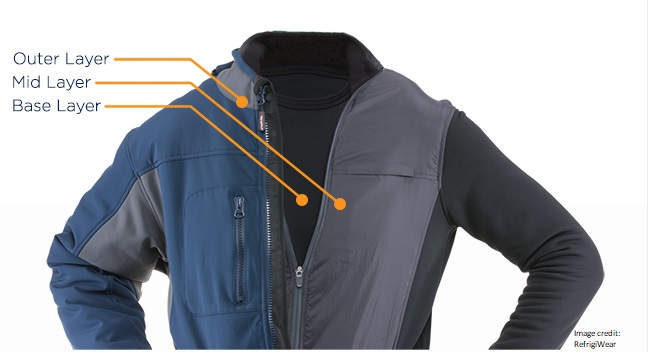
Layering clothing is a time-tested method for maintaining warmth in cold environments, whether outdoors or within cold storage facilities. This technique involves wearing multiple layers, each serving a specific purpose, to effectively regulate body temperature and ensure comfort.
The Three-Layer System
Base Layer (Inner Layer): This layer sits directly against the skin and is designed to wick moisture away, keeping you dry. Materials like merino wool or synthetic fabrics such as polyester are ideal due to their moisture-wicking properties.
Mid Layer (Insulating Layer): Positioned over the base layer, the mid layer provides insulation by trapping body heat. Fleece, down, or synthetic insulations like PrimaLoft are commonly used materials.
Outer Layer (Shell Layer): The outermost layer protects against external elements like wind and moisture. It should be both windproof and breathable to allow moisture from inner layers to escape.
The Base Layer.
The role of a base layer is to move (or ‘wick’) moisture away from your skin. As mentioned earlier, sweating in cold conditions can lead to you becoming seriously cold, and worse case, hypothermic, when you slow down or stop for a break. A base layer will help keep your skin dry and subsequently, you warm.
There are not really any hard and fast rules when it comes to the best material type for base layers, just choose whatever is most comfortable for you. A popular option is the Merino-Blend Thermals from Badger. However, cotton is generally considered a no-no, as it soaks up moisture rather than ‘wicking’ it. Popular options include polyester, nylon, merino wool or silk.
The Middle Layer.
The insulating or middle layer is there to trap in your body heat. Generally, the thicker this layer is the warmer it’ll be. However, a couple of important points to check for include how fast it dries and how breathable the material is. Polyester fleece (polar fleece) is an effective middle layer as it stays warm even when its damp and dries quickly. However, it is quite breathable which means cold wind can blow through if your outer layer does not block it out. For this reason, wind fleece garments are becoming more popular, as they have a wind blocking layer inside.
The Outer Layer.
The outer layer or shell layer is there to provide protection from the elements; wind, rain and snow. You need to choose this layer according to the environment or conditions you’re facing. Softshell can be a good option if you’re battling a chilly wind, as it is wind tight without adding a lot of bulk. In rainy or snowing conditions, you will need something completely waterproof (not just water resistant). Materials such as PVC with a durable water repellent (DWR) are most effective in this situation.
Outer layers can be expensive, but often the pricier they are the drier they will stay and the longer they will last. Choose wisely!
Layering in Cold Storage Work
For individuals working in cold storage environments, where temperatures can be extremely low, layering becomes crucial not only for warmth but also for mobility and safety. Here’s how layering benefits cold storage workers:
Temperature Regulation: Layering allows workers to adjust their clothing based on activity levels and temperature fluctuations within the facility. Adding or removing layers helps maintain a comfortable body temperature, reducing the risk of cold-related illnesses.
Moisture Management: A proper base layer wicks away sweat, preventing moisture buildup that can lead to chilling. This is essential in maintaining warmth during physical activities.
Flexibility and Mobility: Wearing multiple lightweight layers provides better mobility compared to a single bulky garment. This flexibility is vital for performing tasks efficiently without restriction.
Safety Compliance: Employers are responsible for protecting workers from dangerously low temperatures, which can lead to health problems such as frostbite and hypothermia. Layering clothing is a tried-and-true way to maximize comfort and safety in unconditioned environments.
The Bottom Line.
Layering is a tried and tested method of regulating your body temperature. Its important to note, however, you may not always need all three layers, and sometimes, you may need more! Experiment with these methods next time you’re in the elements and you’ll soon work out what works for you!



